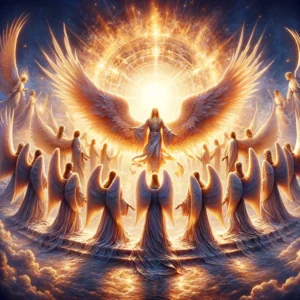
Angelology
Step into the enchanting world of Eastern Orthodox theology, where angelology takes center stage.... View more
Seraphim
-
Seraphim
Seraphim angels in eternal worship around the Divine Light, embodying divine love and purity.
Occupying the highest order, associated with surrounding God’s throne and serving as a symbol of God’s love and light.
“Biblical Relevance The word seraphim appears seven times in the Hebrew Bible (Num 21:6, 8; Deut 8:15; Isa 6:2, 6; 14:29; 30:6). Of those occurrences, two key English renderings include the plural seraphim (based on the transliteration of the Hebrew; e.g., Isa 6:2), and “flying/fiery serpents” (based on the translation of the Hebrew; e.g., Isa 30:6). These differences date to translation decisions made in the Septuagint and Vulgate—some occurrences of the term were transliterated, while others were translated into Greek/Latin (Massine, “Repaint the Sistine Chapel,” 32, referencing research from Provençal, “Regarding the Noun שׂרף, srp; in the Hebrew Bible,” 371–79). The term seraphim also appears in the Great Isaiah Scroll of the Dead Sea Scrolls at the appropriate places in Isaiah (1QIsaa; Isa 6:2, 6; 14:29; 30:6), meaning that there is no textual variant here. Isaiah’s description of the seraphim reads: “Seraphs were standing above him [Yahweh of hosts]. Each had six wings: with two he covered his face, and with two he covered his feet, and with two he flew. And the one called to the other and said, ‘Holy, holy, holy is Yahweh of hosts! The whole earth is full of his glory’ ” (Isa 6:2–3).” (1)
“In Isa 6, the seraphim appear in connection with the enthroned heavenly king, →Yahweh Zebaoth. The following may be said about their position, form, number and function. Their position, ʿōmĕdîm mimmaʿal lô, “standing above” Yahweh (v 2), lends itself to comparison with the raised uraei on the chapel friezes, where the uraei are however without wings. Whether their shape is serpentine or more humanoid is a matter of dispute. As for number, there are probably two seraphim in Isa 6 (cf. v 3a). Concerning their function Isa 6 displays a noteworthy mutation of the uraeus motif (Keel 1977: 113): instead of protecting Yahweh the seraphim need their wings to cover themselves from head to feet from Yahweh’s consuming holiness; Yahweh does not need their protection. Isaiah thus uses the seraphim to underscore the supreme holiness of the God on the throne.” (2)
“According to other investigators, the conception was of Babylonian origin. Friedrich Delitzsch and Hommel associate the seraphim with the Assyrian “sharrapu,” a name which, in Canaan, designated the Babylonian fire-god Nergal. The seraphim, then, would be the flames in which this god manifested himself. An argument against this theory is that until now no one has been able to show that the word “seraph” was ever used as a name of a god. According to a third and more probable theory, the seraphim originally were serpents, as the name implies. Among many peoples of antiquity serpents played an important part in myth and folk-lore. For instance, there were Tiamat in the Babylonian legend of the Creation, and the Uræus serpent in Egypt. Consequently, since the Jews shared the superstitious ideas of surrounding nations in other respects, it should not be a matter of wonder if they adopted this notion as well. That the serpent filled a special rôle among them as a demoniacal being may be seen from the story of Adam’s fall (Gen. 3). In this connection the names “Dragon Spring” and “Serpent Pool” (places in the vicinity of Jerusalem) are worthy of being noted. A brazen serpent brings relief from the effects of the bite of the fiery serpents (Num. 21:9 et seq.) which Yhwh sent among his disobedient people in the wilderness. Isaiah (14:29, 30:6) speaks of fiery, flying serpents and dragons; and a brazen serpent, Nehushtan, stood in the Temple at Jerusalem, and was an object of worship until the time of Hezekiah, who destroyed it as being idolatrous (2 Kings 18:4 et seq.). The worship of Nehushtan was plainly a remnant of ancient superstition, and was reconciled with the worship of Yhwh by connecting Nehushtan with the scourge of snakes in the wilderness and the rescue from them (Num. 21:9 et seq.). Therefore the theory seems possible, even probable, that the seraphim have their counterpart in the flying serpents of Isaiah (comp. also 2 Esd. 15:29). It is only natural that these winged guardians of Yhwh’s throne were soon ranked as higher beings and invested with the human form or with some features of the human body; and it was because of the very fact that they were adopted into the Yhwh cult that they were, in process of time, ennobled and spiritualized.” (3)
“Seraphs are described by some scholars as winged demons or as guardian-griffins (called šerref in Egyp. [BDB, 977]). Others make a connection with the snake cults of the ANE, pointing both to the fiery serpents (KJV) that afflicted the Israelites in the wilderness and to the apotropaic bronze serpent (see Nehushtan), which later was destroyed because it had become an object of worship (Num. 21:6–9; 2 Ki. 18:4). According to this view, the term for “fiery [serpent]” (śārāp; cf. also Deut. 8:15; Isa. 14:29; 30:6), which possibly alludes to the “burning” sting of the snakes’ fatal bite or to their bright “glowing” color, is the same term used for “seraph.” However, the seraphs as described by Isaiah are more like men than snakes. Moreover, although they handled hot coals from the altar (Isa. 6:6–7) or may have had fiery countenances, some scholars have thought that their name is derived, not from the verb meaning “to burn” (śārap H8596), but from Arabic šarafa, “to be noble,” suggesting that the seraphs were regarded as “princes” or “nobles” (F. H. W. Gesenius, Gesenius’ Hebrew and Chaldee Lexicon [repr. 1957], 795–96; this and other etymologies are not widely accepted, however).” (4)
(1) Stocker, Abigail, and John D. Barry. “Seraphim.” Ed. John D. Barry et al. The Lexham Bible Dictionary 2016: n. pag. Print.
(2) Mettinger, T. N. D. “Seraphim.” Ed. Karel van der Toorn, Bob Becking, and Pieter W. van der Horst. Dictionary of deities and demons in the Bible 1999: 743. Print.
(3) Singer, Isidore, ed. The Jewish Encyclopedia: A Descriptive Record of the History, Religion, Literature, and Customs of the Jewish People from the Earliest Times to the Present Day, 12 Volumes 1901–1906: 202. Print.
(4) Silva, Moisés, and Merrill Chapin Tenney. The Zondervan Encyclopedia of the Bible, Q-Z 2009: 419–420. Print.
-
This discussion was modified 1 year, 3 months ago by
Justinian of Arizona.
-
This discussion was modified 1 year, 3 months ago by
Justinian of Arizona.
-
This discussion was modified 1 year, 3 months ago by
Justinian of Arizona.
-
This discussion was modified 1 year, 3 months ago by
Justinian of Arizona.
-
This discussion was modified 1 year, 3 months ago by
Log in to reply.


